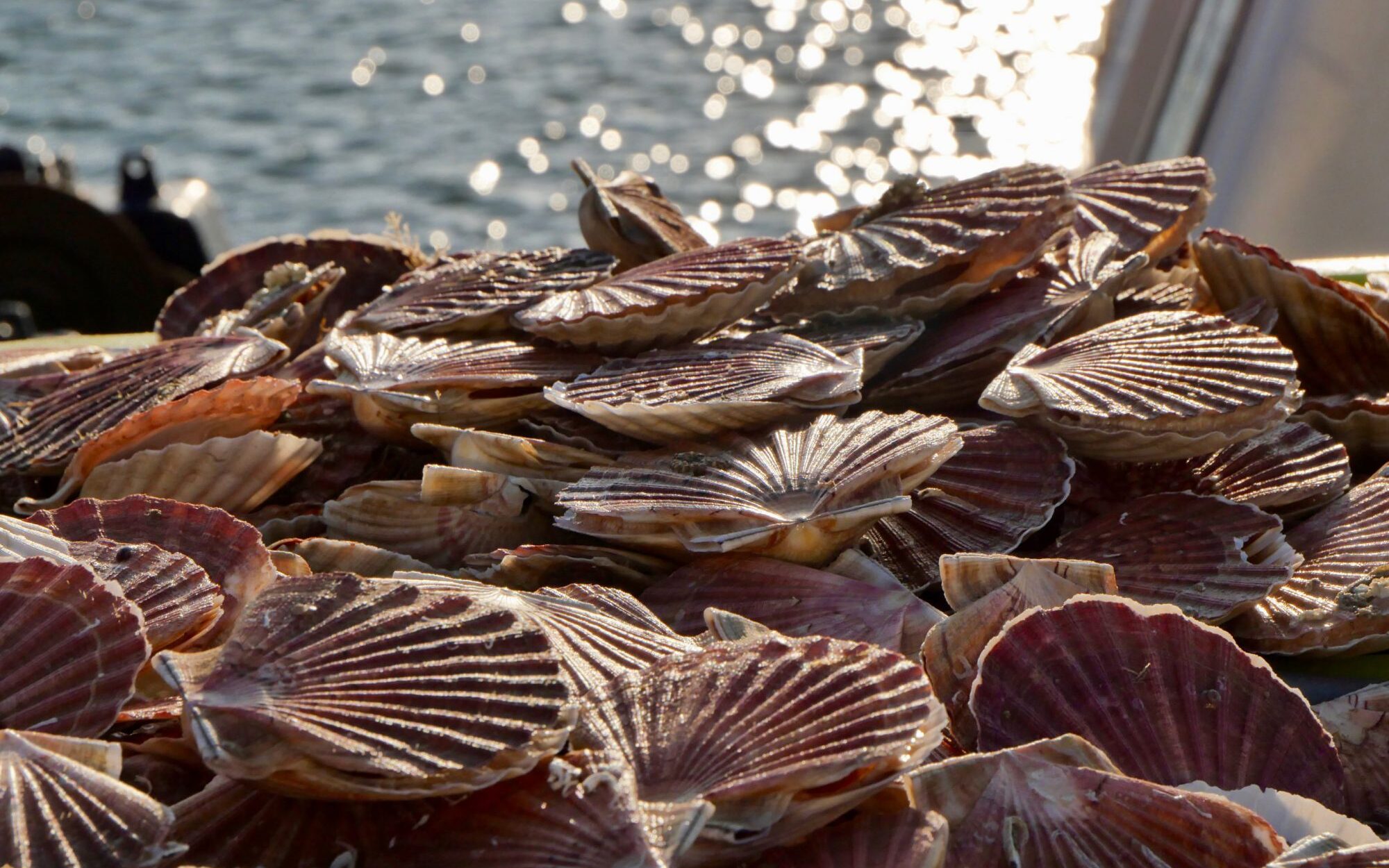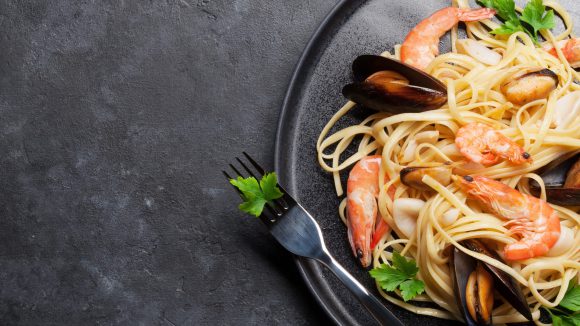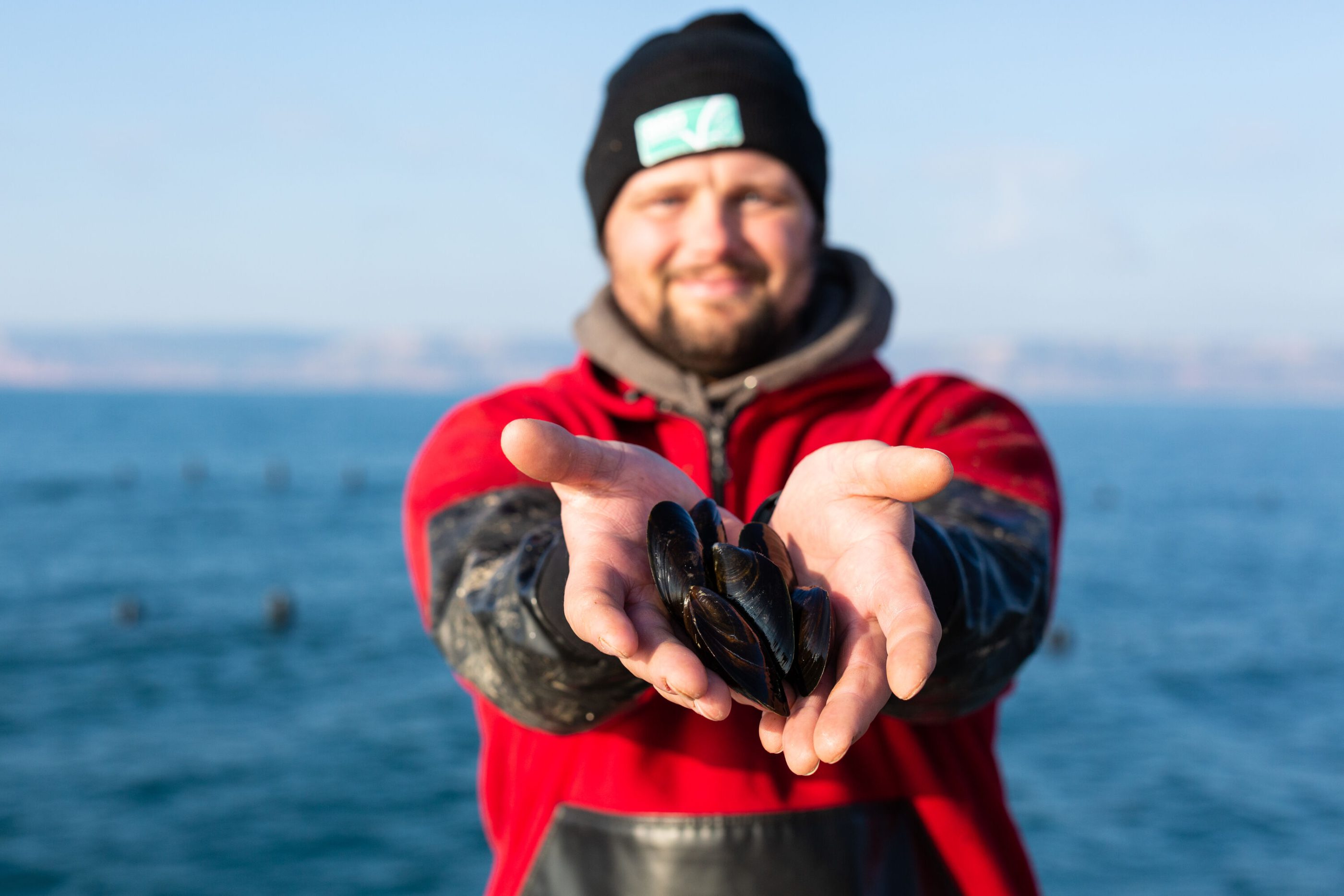
Learn more about scallops
Scallops are everyone’s favourite seafood! They are easy to cook, delicious to eat, and have a delicate, sweet flavour. They are also high in protein and packed full of minerals such as selenium, zinc, copper and omega 3, which makes them a super healthy meal choice. Scallops are popular all over the world, but consumers in Asia and Europe eat the most.
Scallops are filter feeding bivalve molluscs that live mainly on sand or gravel seabeds and come in a variety of colours, from brilliant red and purple, to orange, yellow or white. Farmed species are certified under the ASC Bivalve Standard.
Some species can live up to 20 years old, and their value is closely related to their size, with larger ones commanding a premium.
The edible meat of a scallop is the adductor muscle, which is large and powerful, and used to open and close the shell, enabling it to ‘swim.’
In the wild
Around the world, there are more than 400 known species of scallops. Their habitats vary from relatively shallow coastal waters to deep seabeds. Scallops can also be found living in and around rocks, on coral, rubble, sea grass, kelp, sand, or mud. The juveniles attach themselves to static objects via their byssal threads.
Some scallops such as the American sea scallop, Placopecten magellanicus, have smooth shells and edges, while others including the Great Atlantic scallop, Pecten maximus, commonly known as the king scallop, have ribbed shells and concentric lines that indicate their growth history.
Peruvian calico scallops, Argopecten purpuratus, are one of the smallest species, measuring 40 to 60 mm.
Farming scallops
Global capture fisheries cannot meet the demand for scallops due to overfishing in the past, and scallop farming has become an increasingly important global aquaculture activity. Scallop cultivation was developed in Japan in the late 1960s where it rapidly restored production of the Yesso scallop, Patinopecten yessoensis. Success in Japan encouraged other countries to develop their own farmed industries.
Global farmed scallop production amounted to 2.12 million tonnes in 2018, with a value of USD 5.8 billion. China produced more than 90% of this volume. Other important producing countries are Japan, Peru, Chile, South Korea and Russia.
Scallops are farmed in several different ways. Hanging culture uses rafts or floating longlines, under which pearl lanterns, mesh pockets or trays are suspended in the water.
Pearl nets are small pyramid shaped nets, typically hung ten to a line, in which juvenile scallops are grown, before being transferred to circular, collapsible lantern nets or trays. Lanterns and nets must be cleaned regularly, to ensure a good flow of water and plankton through the mesh.
Scallops may also be hung by their ‘ears’ from a submerged dropper line. This method involves drilling a hole in the ear of larger scallops, which can be densely stocked in pairs.
Another method is to cement scallops by their flat shell to a hanging rope, which results in similar growth and mortality rates as ear hanging, but with the advantage that smaller scallops can be used.
Bottom culture is used in conjunction with, or as an alternative to hanging culture. This method is cheaper, but growing times can be much longer as there is less access to plankton.
Spat (as scallop spawn is known) may be reared in a hatchery or collected in the wild in mesh bags suspended in the water column, on a line anchored to the seafloor.
Impacts of farming scallops
Biodiversity
As with other bivalve aquaculture species certified to the ASC Standard, scallop farms minimise their impact on the environment in several ways, such as ensuring the farms are not sited in areas with any key ecological or biological functions. An environmental management plan must be put in place to ensure there are no adverse effects.
Pollution
ASC certified bivalve farms are required to manage the organic deposits on the sediment beneath the farm in a responsible manner, and to keep sulphide levels within set limits. As filter feeders, scallops consume no wild fish, do not require artificial feeding, and actually clean the water as they feed, so deposits are minimal.
Diseases
ASC certified scallop farms must adhere to rigorous requirements to minimise disease outbreaks. If chemicals are used, only those that do not harm the marine environment are permitted. Farms must also ensure that actions to prevent diseases do not cause harm to endangered species or have a permanent impact on critical habitats.
Wild seed collection
Any wild scallop seed collected for use aquaculture must be sourced from well managed stocks.
Social
ASC certification imposes strict requirements based on the core principles of the International Labour Organisation (ILO), which include prohibiting the use of child labour and forced labour. All ASC certified farms are safe and equitable working environments where employees earn a decent wage and have regulated working hours.
Eating scallops
Scallops pan fried until crisp and golden, finished with a squeeze of lime, and served with a handful of freshly chopped coriander and a light dressed salad, make a perfect starter or main dish. Scallops can also be eaten raw in a ceviche, or finely sliced and served with a tangy Asian dressing. This method works particularly well with larger scallops. Smaller scallop species are generally cooked and used in everything from salads to pastas, fish pies to curries.
Explore More

Learn more about Seafood Farming
Find out how farmed seafood can help feed a growing global population, why fish farming needs to be done responsibly and how you can make a responsible choice.

Visit our Blog
Find out what’s behind the label, what’s going on in the world of aquaculture and how the Aquaculture Stewardship Council is updating and improving its programmes regularly.

The Aquaculture Stewardship Council
We run the world’s leading certification programme for responsibly farmed seafood. Learn about our Certification Programmes and our Impact.



